
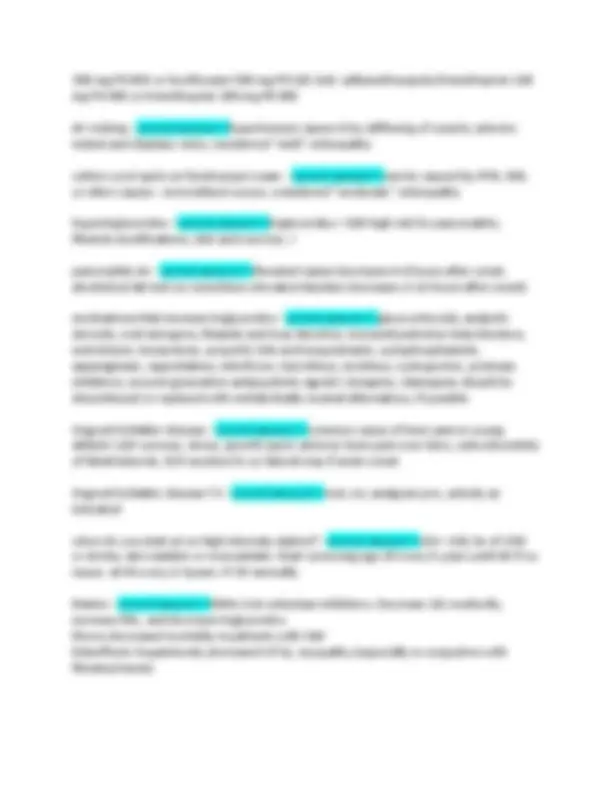
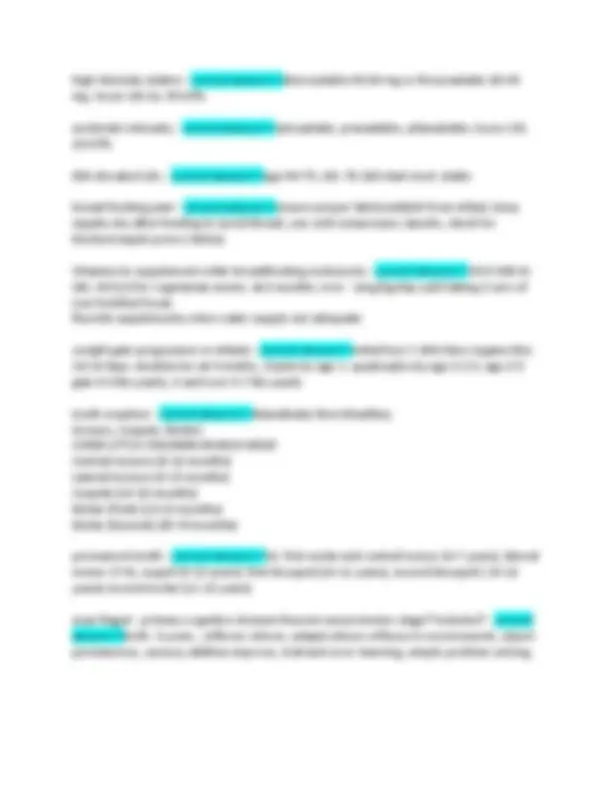
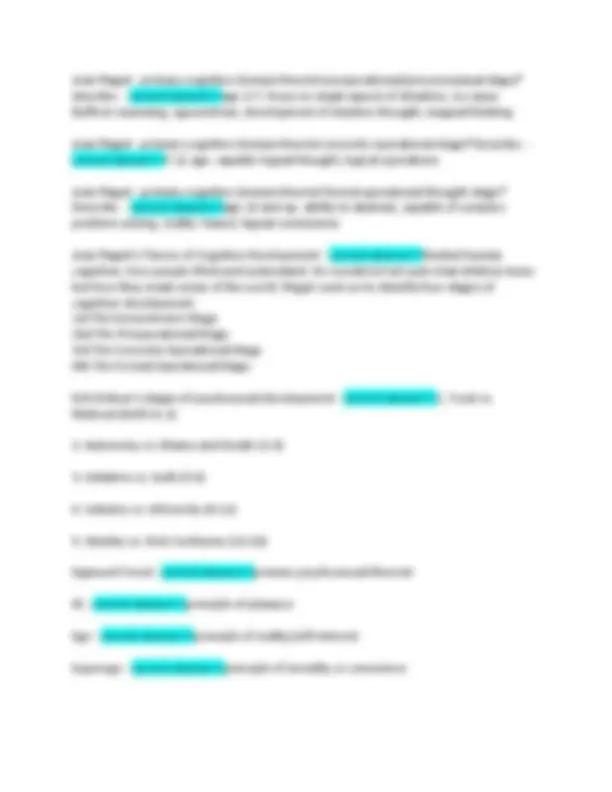

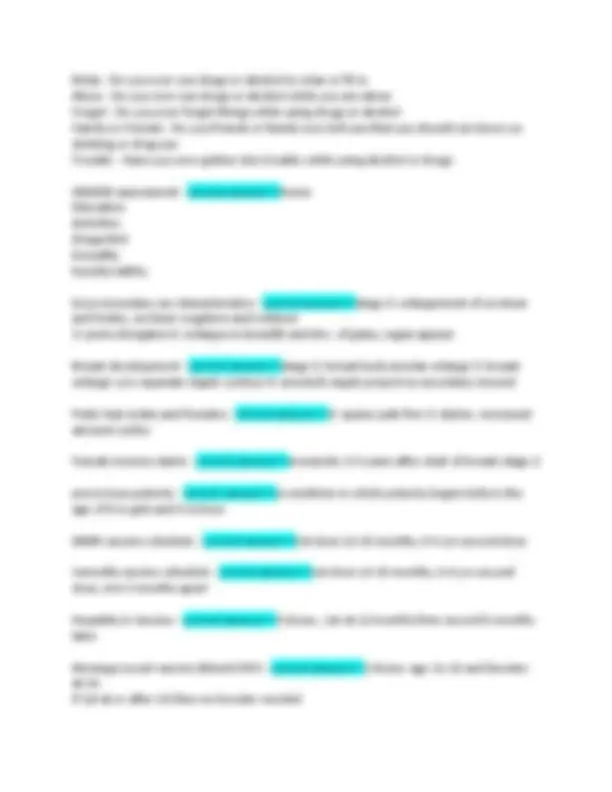
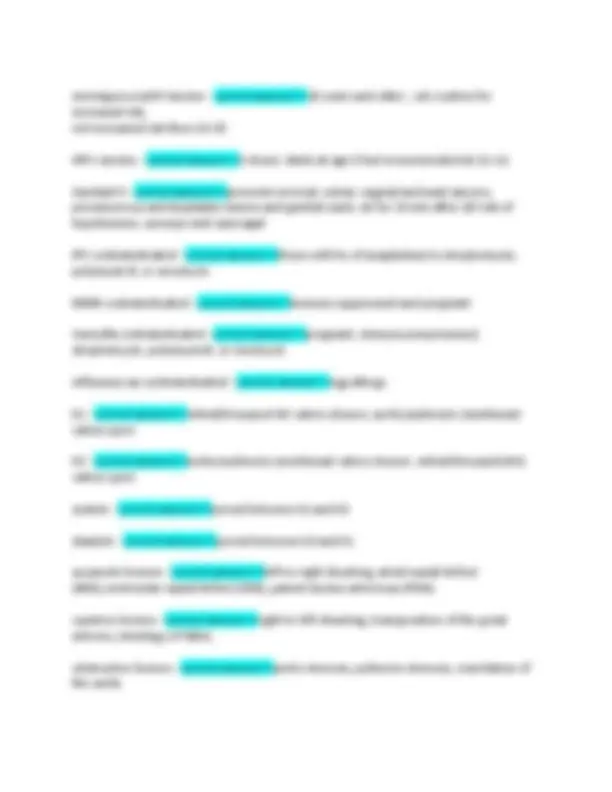
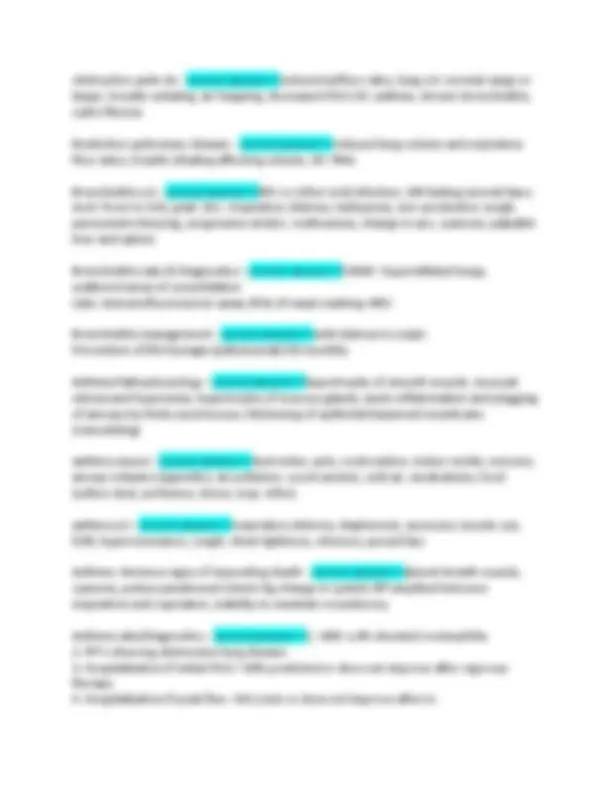
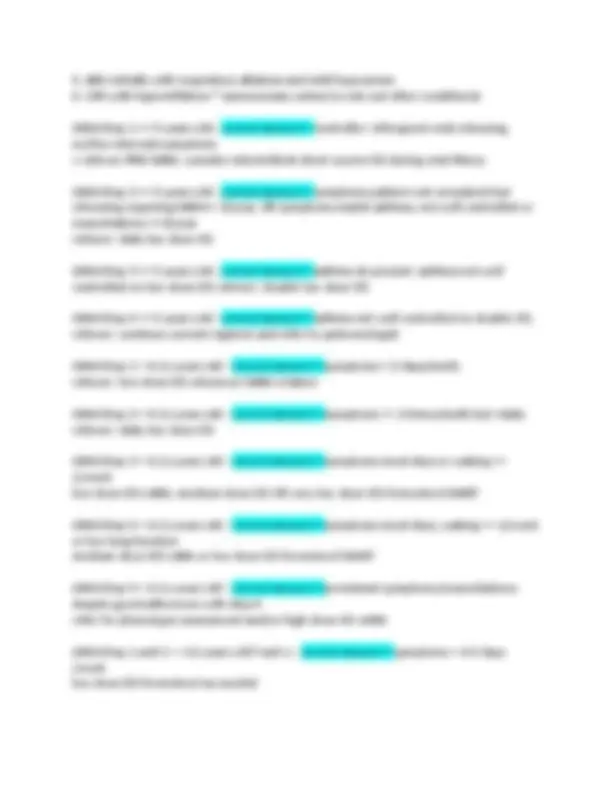
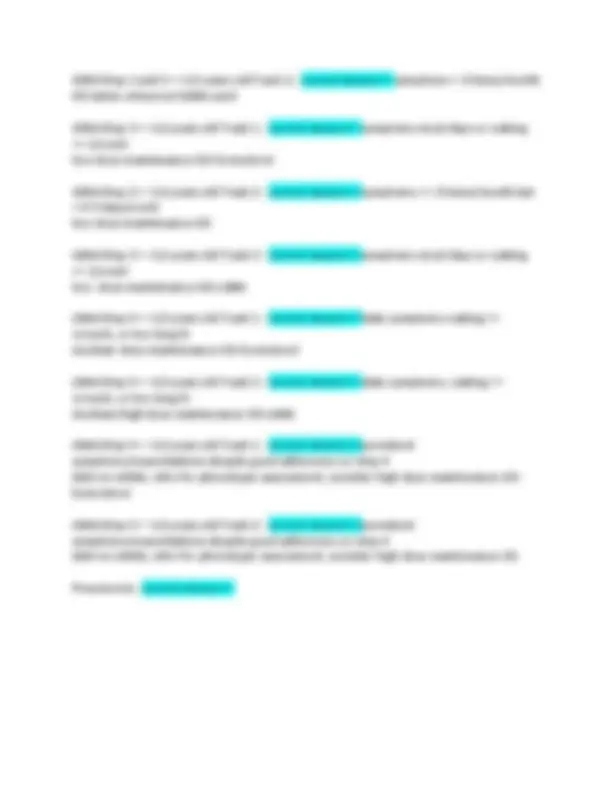


Study with the several resources on Docsity

Earn points by helping other students or get them with a premium plan


Prepare for your exams
Study with the several resources on Docsity

Earn points to download
Earn points by helping other students or get them with a premium plan
Community
Ask the community for help and clear up your study doubts
Discover the best universities in your country according to Docsity users
Free resources
Download our free guides on studying techniques, anxiety management strategies, and thesis advice from Docsity tutors
Which of the following laboratory tests are most widely accepted as indicators of the progression of HIV infection? - correct answer>>CD4 count and viral load A patient who is 28 weeks pregnant reports a single episode of vaginal bleeding. History indicates normal prenatal progress to date, and the patient denies pain, vaginal itching, or discharge. Which of the following is the most appropriate intervention to aid in the diagnosis of this case? - correct answer>>Ultrasound A 3-year-old patient presents at an inner-city clinic with fever, cough, malaise, and loss of appetite. The patient lives with several relatives, including a grandmother who also has a cough. Which of the following diagnostic tests would be most appropriate for the patient? - correct answer>>Sputum culture Which of the following best describes psoriatic lesions in an elderly patient? - correct answer>>Red, sharply defined plaques with silvery scales
Typology: Exams
1 / 15

This page cannot be seen from the preview
Don't miss anything!










Treatment for Bronchitis - correct answer>>SABA-albuterol and inhaled anticholinergic - ipratropium What is actinic keratosis? - correct answer>>A precancerous skin growth that occurs on sun-damaged skin. How is actinic keratosis diagnosed? - correct answer>>Diagnosed with a skin biopsy. What is the recommended follow-up for actinic keratosis? - correct answer>>Follow-up with a dermatologist. How is actinic keratosis treated? - correct answer>>Treated with cryotherapy or 5-fu cream (Fluorouracil Seborrheic keratosis - correct answer>>a benign skin growth that has a waxy or "pasted on" look Trephination - correct answer>>make hole in nail by drilling or piercing allow blood to drain subclinical hypothyroidism - correct answer>>Elevated TSH, normal T4, normal T primary hypothyroidism - correct answer>>Elevate TSH level, decreased T4 levels and low or normal T hypothyroidism TX - correct answer>>Levothyroxine (Synthroid) 25-50mcg daily in AM on empty stomach, check TSH every 6-8 weeks primary hyperthyroidism - correct answer>>Low TSH, high T4 and high or normal T subclinical hyperthyroidism - correct answer>>low TSH, normal T3 and T hyperthyroidism tx - correct answer>>methimazole, PTU, radioactive iodine with prednisone thyroid storm - correct answer>>thyrotoxic crisis, relatively rare, life-threatening condition caused by exaggerated hyperthyroidism immediate hospitalization
Ectopic Pregnancy Risk Factors - correct answer>>Any factor that compromises tubal patency (STIs, assisted reproductive technologies, tubal surgery, and contraceptive intrauterine device [IUD]). PID STDs ectopic pregnancy symptoms - correct answer>>Bleeding, pelvic pain missed menses. If rupture bleeding, shoulder pain, N/V, hypotension or tachycardia PID - correct answer>>cervical motion tenderness, infertility, uterine tenderness and or adnexal tenderness PID TX - correct answer>>ceftriaxone 500mg (1g >150kg) IM x1 + doxy 100mg PO BID x days +metronidazole 500mg PO BID 14 days Gonorrhea TX - correct answer>>1st ceftriaxone 500 mg IM x1 dose; 2nd azithromycin 2gm oral and gentamicin 240 mg intramuscularly as a single dose or doxy 100mg BID x7days or ciprofloxacin 500 mg orally as a single dose or cefixime 800 mg orally as a single dose chlamydial infection has not been excluded w/gonorrhea - correct answer>>patients should also receive oral doxycycline for 7 days (unless they are receiving the gentamicin plus azithromycin regimen Wilms tumor (nephroblastoma) - correct answer>>most common renal malignancy in children. Usually presents as a unilateral, painless, abdominal/flank mass; less commonly presents bilaterally. palpate lightly, order US Acute bacterial prostatitis - correct answer>>most frequent urologic diagnosis in men <50 years old. Commonly caused by Escherichia coli bacteria. extreme lower abdominal, ejaculatory, rectal, perineal pain. May be successfully treated with antibiotics, but a prolonged course is frequently required if chronic prostatitis follows the acute occurrence baby w/ UTI - correct answer>>renal and bladder US for all infants 2-24mnths. acute prostatitis w/o sepsis w/o blockage tx - correct answer>>1st: ciprofloxacin 500 mg PO BID or ofloxacin
high intensity statins - correct answer>>Atorvastatin 40-80 mg or Rosuvastatin 20- 40 mg, lower LDL by 35-63% moderate intensity - correct answer>>simvastatin, pravastatin, pitavastatin, lower LDL 22 - 47% DM elevated LDL - correct answer>>age 40 - 75, LDL 70-189 start mod. statin breast feeding pain - correct answer>>ensure proper latch/unlatch from infant, keep nipples dry after feeding to avoid thrush, use cold compresses, lanolin, check for blocked nipple pores ( blebs) Vitamins to supplement while breastfeeding exclusively - correct answer>>Vit D 400 IU QD, Vit b12 for vegetarian moms. at 6 months. Iron - 1mg/kg/day until taking 2 serv of iron fortified foods fluoride supplements when water supply not adequate weight gain progression in infants - correct answer>>initial loss 7-10% then regains this 10 - 14 days. doubles bw at 4 mnths., triples by age 1. quadruples by age 2-2.5, age 2- 5 gain 4-6 lbs yearly, 6 and over 5-7 lbs yearly tooth eruption - correct answer>>Mandibular then Maxillary Incisors, Cuspids, Molars COME LITTLE CHILDREN MUNCH MEAT Central Incisors (8-12 months) Lateral Incisors (9-13 months) Cuspids (16-22 months) Molar (First) (13-19 months) Molar (Second) (25-33 months) permanent teeth - correct answer>>32, first molar and central incisor (6-7 years), lateral incisor (7-9), cuspid (9-12 years), first bicuspid (10-11 years), second bicuspid ( 10- 12 years) second molar (11-13 years) Jean Piaget - primary cognitive domain theorist sensorimotor stage? Includes? - correct answer>>birth - 2 years , reflexes: inborn, adapts inborn reflexes to environment, object permanence, sensory abilities improve, trial and error learning, simple problem solving
Jean Piaget - primary cognitive domain theorist preoperational/preconceptual stage? describe. - correct answer>>age 2-7, focus on single aspect of situation, no cause &effect reasoning, egocentrism, development of intuitive thought, magical thinking Jean Piaget - primary cognitive domain theorist concrete operational stage? Describe. - correct answer>> 7 - 11 age. capable logical thought, logical operations Jean Piaget - primary cognitive domain theorist formal operational thought stage? Describe. - correct answer>>age 12 and up. ability to abstract, capable of complex problem solving, reality- based, logical conclusions Jean Piaget's Theory of Cognitive Development - correct answer>>Studied human cognition, how people think and understand. He wondered not just what children knew but how they made sense of the world. Piaget went on to identify four stages of cognitive development. 1st The Sensorimotor Stage 2nd The Preoperational Stage 3rd The Concrete Operational Stage 4th The Formal Operational Stage Erik Erikson's stages of psychosocial development - correct answer>>1. Trust vs. Mistrust (birth to 1)
Trisomy 21 (Down Syndrome) - correct answer>>presence of 3rd chromosome, increased maternal and paternal age increase risk, intellectual disability may be mild to severe Trisomy 21 (Down Syndrome) physical findings - correct answer>>microcephaly, flattened nose, protruding tongue, inner epicanthal folds, upward slanting eyes, short broad hands, single palmar crease, delayed growth, hypotonia, brushfield spots Trisomy 21 (Down Syndrome) manifestations that may occur - correct answer>>seizures, congenital heart defects, hearing/vision impairment, obesity, leukemia, early dementia, endocrine abnormalities, esophageal/duodenal atresia, atlanto-axial instability (neck instability c1 and c2) Trisomy 21 (Down Syndrome) management - correct answer>>refer as needed, no cure Klinefelter syndrome XXY - correct answer>>an extra X chromosome causes physical abnormalities, only n males, not hereditary, genetic condition, presents in puberty, most common cause of infertility and hypogonadism, Klinefelter syndrome XXY manifestations - correct answer>>tall stature, transverse crease, abnormal body proportions, underdeveloped secondary sex charac. gynecomastia, learning disability, personality impairment Klinefelter syndrome XXY management - correct answer>>refer to endocrinology, POC includes testosterone replacement, breast tissue removal, speech PT and educational therapy, fertility treatment, psychosocial counseling XO Karyotype (Turner's Syndrome) - correct answer>>Females sex chromosome abnormality Occurs in 1:2,000 births most don't survive in utero XO Karyotype (Turner's Syndrome) findings - correct answer>>lymphedema, webbed neck, low hairline, learning disability, lack of secondary sex charac. , "Shield" shaped chest widely spaced nipples, variety of head and neck abnormalities, HTN, infertility, bicuspid aortic valve, coarctation of aorta XO Karyotype (Turner's Syndrome) management - correct answer>>refer to endo, growth hormone therapy, estrogen replacement therapy, preconception counseling,
Marfan Syndrome - correct answer>>genetic connective tissue disorder that affects the skeletal, cardiac and ophthalmic system Marfan Syndrome characteristics - correct answer>>Tall, slender long narrow face Arm spam exceeds height Sunken or protruding chest (pectus carnitum or excavatum) ectopia lentis, iridodonesis, high arched narrow palate, Palpitations Hypermobility of joints, genu recurvatum, kyphoscoliosis, aortic regurgitation, mitral valve prolapses, aortic root dilatation or aneurysm Weakened vessel walls (aneurysm) Tay-Sachs disease - correct answer>>more likely to occur in Ashkenazic jewish pop. normal at birth, deterioration begins 3-6 months of age Tay-Sachs disease progression - correct answer>>decreased muscle tone, cherry red macula, listlessness, Blindness, Deafness, seizures, dementia, vegetative state, death Tay-Sachs disease management - correct answer>>refer as need, airway management, antiseizure therapies, multidisciplinary consultations DiGeorge/Velocardiofacial syndrome - correct answer>>Congenital of the parathyroid glands, thymus, and contrapuntal region of the heart. CONGENITAL HEART DEFECTS DiGeorge/Velocardiofacial syndrome presentation - correct answer>>increase susceptibility to infection, abnormal facies, lateral displacement of inner canthi, short palpebral fissures, changes to appearance of eyes, ears and nose, congenital heart defects, hypocalcemia, hypoparathyroidism, cognitive/behavioral/ psychiatric problems DiGeorge/Velocardiofacial syndrome - correct answer>>abx, vaccinations, PT OT refer as needed APGAR score - correct answer>>a scale of 1-10 to evaluate a newborn infant's physical status at 1 and 5 minutes after birth; appearance, pulse, grimace, activity and respirations CRAFT screening tool for children under 21 - correct answer>>Car - Have you ever ridden in a car driven by someone who was high or had been using drugs or alcohol
meningococcal B Vaccine - correct answer>>10 years and older , cdc routine for increased risk, not increased risk then 16- 23 HPV vaccine - correct answer>>2 doses: starts at age 9 but recommended at 11-12. Gardasil 9 - correct answer>>prevents cervical, vulvar, vaginal and anal cancers, precancerous and dysplastic lesions and genital warts. sit for 15 min after d/t risk of hypotension, syncope and vasovagal IPV contraindicated - correct answer>>those with hx of anaphylaxis to streptomycin, polymyxin B, or neomycin MMR contraindicated - correct answer>>immune suppressed and pregnant Varicella contraindicated - correct answer>>pregnant, immunocompromised, streptomycin, polymyxin B, or neomycin influenza vax contraindicated - correct answer>>egg allergy S1 - correct answer>>mitral/tricuspod AV valves closure, aortic/pulmonic (semilunar) valves open S2 - correct answer>>aortic/pulmonic (semilunar) valves closure. mitral/tricuspid (AV) valves open systole - correct answer>>period between S1 and S diastole - correct answer>>period between S2 and S acyanotic lesions - correct answer>>left to right shunting; atrial septal defect (ASD),ventricular septal defect (VSD), patent ductus arteriosus (PDA) cyantoic lesions - correct answer>>right to left shunting; transposition of the great arteries, tetralogy of fallot, obstructive lesions - correct answer>>aortic stenosis, pulmonic stenosis, coarctation of the aorta
atrial septal defect (ASD) - correct answer>>murmur 2-3 may or may not be heard (systolic)(LUSB), fixed split s 2 is common, EKG: rt ventricular hypertrophy (RVH), X-ray: cardiomegaly, increased pulmonary vascular markings atrial septal defect (ASD) management - correct answer>>refer to pediatric cardiology, small will close moderate to large need surgical intervention, supportive care reg. f/ui ventral septal defect (VSD) - correct answer>>murmur 2-5 (systolic), holosystolic thrill may be felt at LLSB, EKG: LVH progressing to biventricular hypertrophy if Lg VSD, X-ray: cardiomegaly, increased pulmonary vascular markings, ventral septal defect (VSD) management - correct answer>>refer peds cardiology, same as asd terazosin Hytrin - correct answer>>alpha blocker, prevents catecholamines from binding to a1adrenergic receptors reducing smooth muscle tone in neck patent ductus arteriosus (PDA) - correct answer>>more common premature infants, Mumur LUSB 2-5, holosyystolic, machinery sound, EKG: LVH to biventricular hypertrophy, X-ray: cardiomegaly, increased pulmonary vascular markings patent ductus arteriosus (PDA) management - correct answer>>refer to peds cards., preterm infant's prostaglandin inhibitors (ibuprofen, indomethacin) percutaneous occlusion preferred in adolescents Transposition of the great artieries - correct answer>>mumur VSD, EKG: RVH, Xray: egg on string, cardiomegaly, increased pulmonary vascular findings Transposition of the great artieries management q - correct answer>>refer peds cards, supportive care tetralogy of fallot - correct answer>>Four defects: Large VSD, pulmonary stenosis, overriding aorta, RVH, loud murmur, ejection click, EKG: rt axis deviation, RVH XRAY: boot shaped heart, refer to peds cards aorti stenosis - correct answer>> 2 - 5 murmur RUSB, thrill present, ejection click present, EKG: LVH, XRAY: normal to CHF aorti stenosis management - correct answer>>refer peds cards, balloon aortic valvuloplasty, reg f/u esp, with sports participation
obstructive pulm dx - correct answer>>reduced airflow rates, lung vol. normal range or larger, trouble exhaling, air trapping, decreased FEV1 EX: asthma, chronic bronchiolitis, cystic fibrosis Restrictive pulmonary disease - correct answer>>reduced lung volume and expiratory flow rates, trouble inhaling affecting volume, EX: PNA Bronchiolitis s/s - correct answer>>RSV or other viral infection, URI lasting several days, mod. fever to 102, grad. dev. respiratory distress, tachypnea, non-productive cough, paroxymal wheezing, progressive stridor, restlessness, change in aoc, cyanosis, palpable liver and spleen Bronchiolitis Labs & Diagnostics - correct answer>>CXRAY: hyperinflated lungs, scattered areas of consolidation Labs: immunofluorescence assay (IFA) of nasal washing +RSV Bronchiolitis management - correct answer>>mild distress tx outpt. Prevention of RSV:Synagis (palivizumab) IM monthly Asthma Pathophysiology - correct answer>>hypertrophy of smooth muscle, mucosal edema and hyperemia, hypertrophy of mucous glands, acute inflammation and plugging of airways by thick,viscid mucus, thickening of epithelial basement membrane (remodeling) asthma causes - correct answer>>dust mites, pets, cockroaches, indoor molds, exercise, airway irritants (cigarettes, air pollution, wood smoke), cold air, medications, food (yellow dye), perfumes, stress, resp. infect. asthma s/s - correct answer>>respiratory distress, diaphoresis, accessory muscle use, SOB, hyperresonance, cough, chest tightness, wheezes, pursed lips Asthma: Ominous signs of impending death - correct answer>>absent breath sounds, cyanosis, pulsus paradoxus(>10mm Hg change in systolic BP amplitud between inspiration and expiration, inability to maintain recumbency Asthma Labs/Diagnostics - correct answer>>1. WBC with elevated eosinophilia